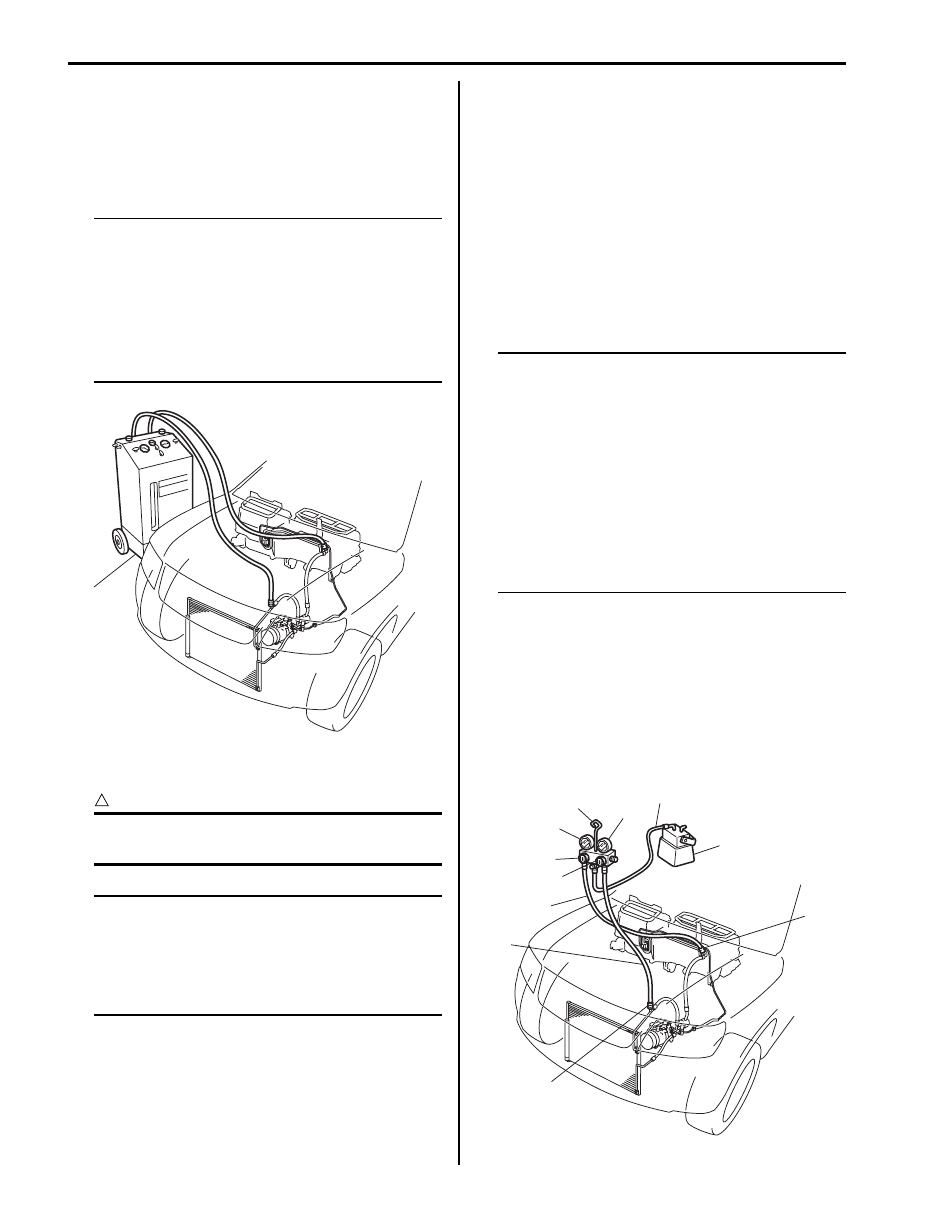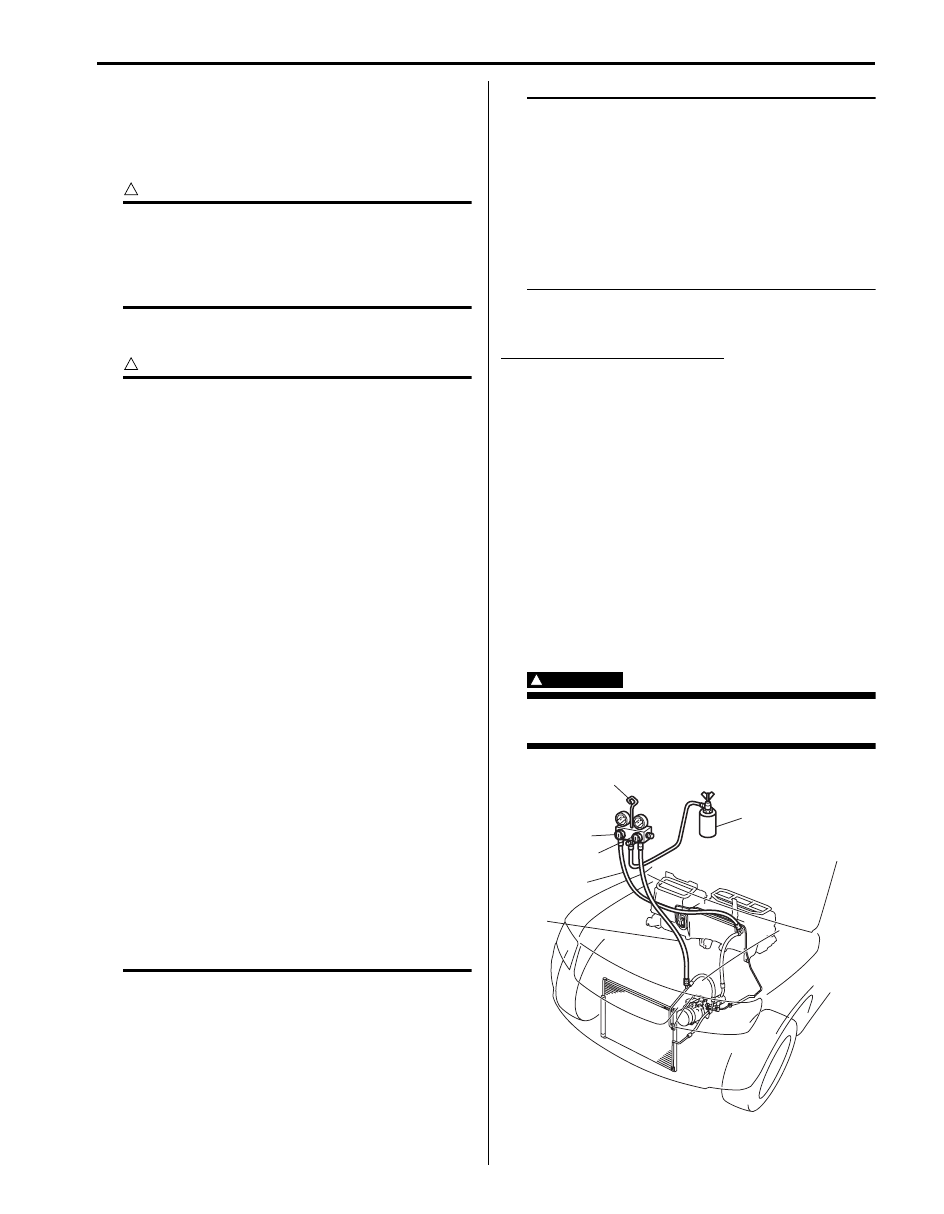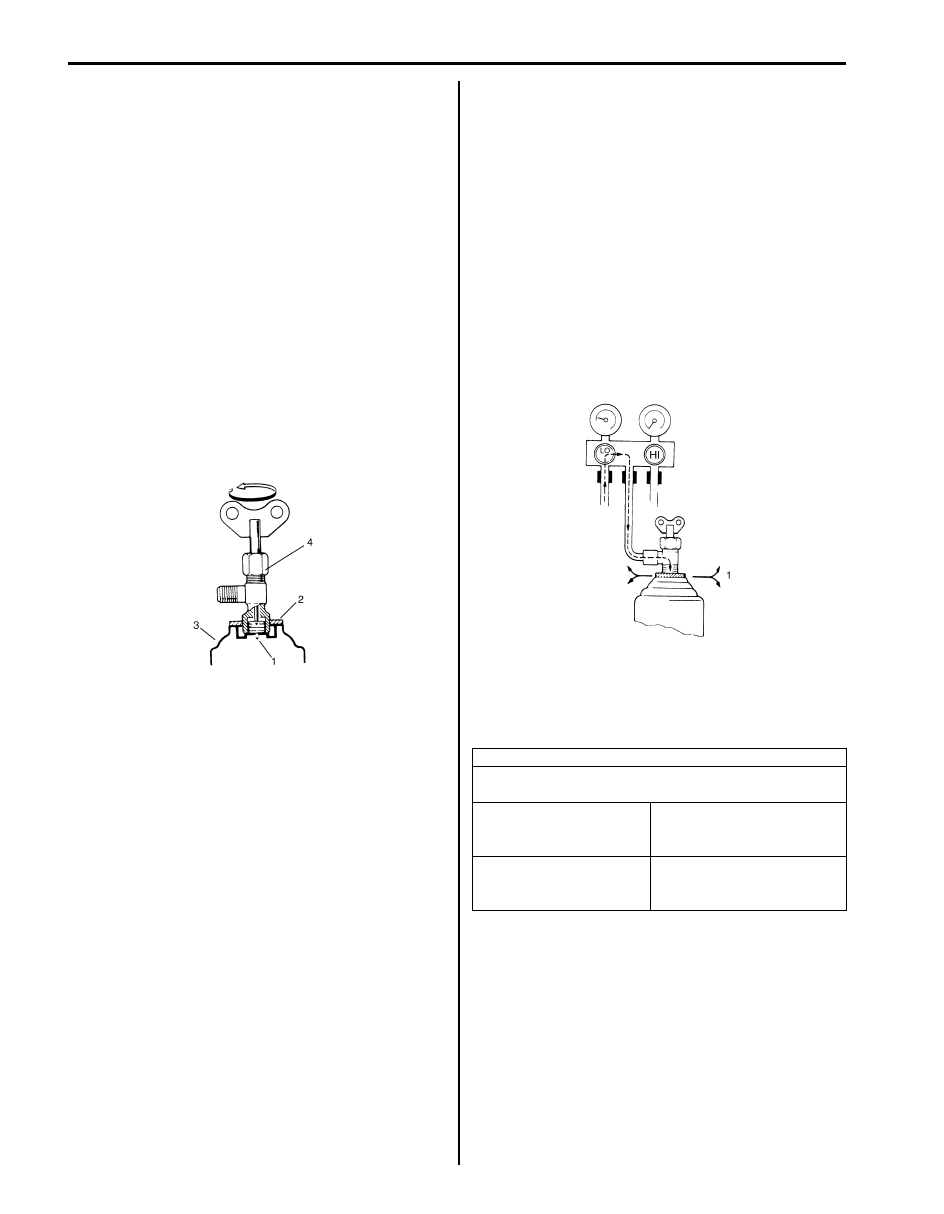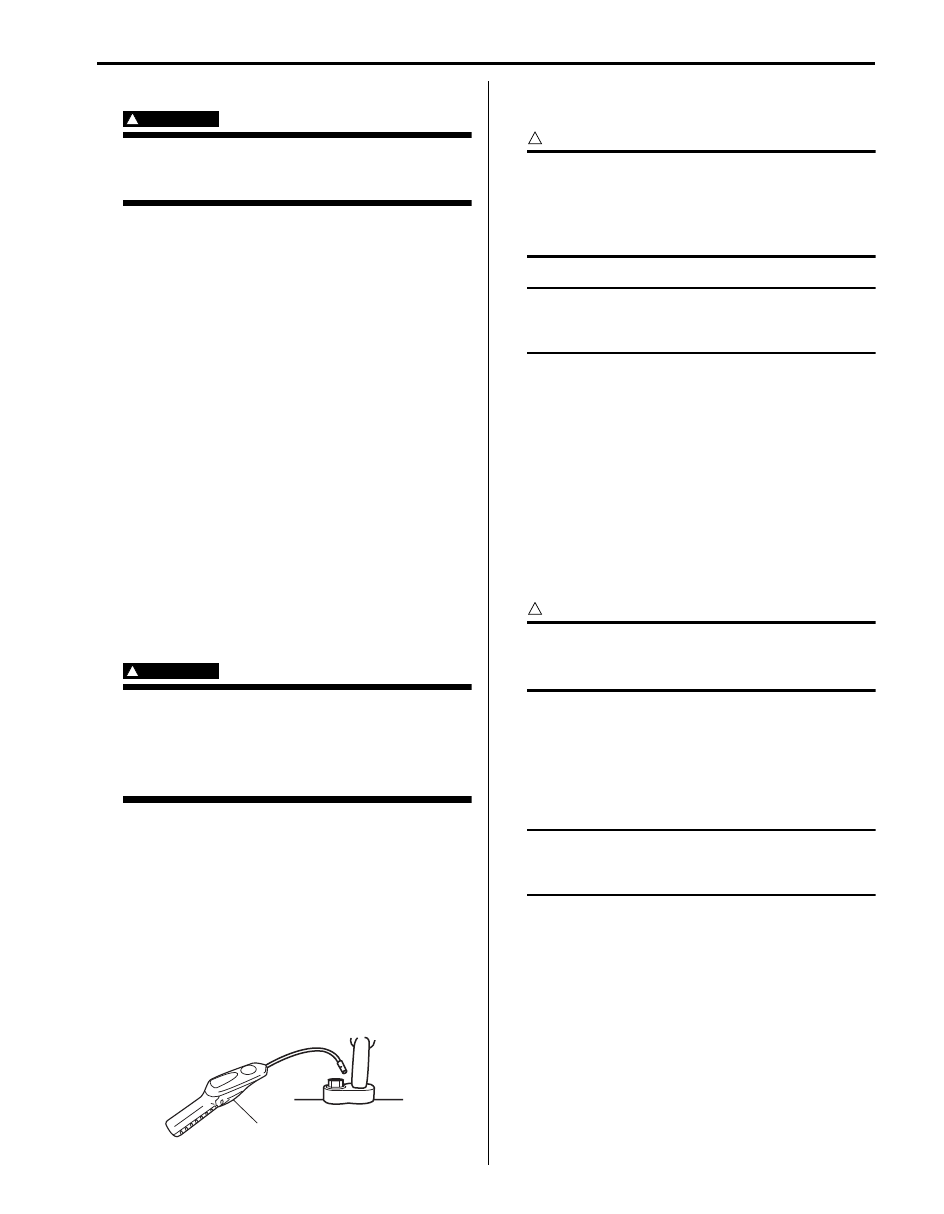Suzuki Grand Vitara JB627. Manual — part 286

7B-60 Air Conditioning System:
Recovery
When discharging refrigerant out of A/C system, always
recover it by using refrigerant recovery and recycling
equipment (1). Discharging refrigerant HFC-134a
(R134a) into atmosphere would cause adverse effect to
environments.
NOTE
• After recovering refrigerant from system
the amount of removed compressor oil
must be measured for replenishing
compressor oil. Refer to “Precautions on
Replenishing Compressor Oil”.
• When handling recovery and recycling
equipment, be sure to follow the
instruction manual for the equipment.
Evacuation
CAUTION
!
Do not evacuate before recovering
refrigerant in system.
NOTE
Once A/C system circuit is opened (exposed
to atmospheric air) air conditioning system
must be evacuated by using a vacuum pump.
The A/C system should be attached with a
manifold gauge set, and should be evacuated
for approx. 20 minutes.
1) Connect high charging hose (1) and low charging
hose (2) of manifold gauge set (3) respectively as
follows:
High charging hose (1)
→ High pressure charging
valve (4) on discharge hose
Low charging hose (2)
→ Low pressure charging
valve (5) on suction pipe
2) Attach center charging hose (6) of manifold gauge
set (3) to vacuum pump (7).
3) Operate vacuum pump (7), and then open
discharge-side valve (9) (Hi) of manifold gauge set
(3).
If there is no blockage in the system, there will be an
indication on high pressure gauge (10).
In this case, open the other-side valve (8) (Lo) of the
set and repair the system.
4) Approx. 10 minutes later, low pressure gauge (11)
should show a vacuum lower than –100 kPa (–1.0
kg/cm
2
, –760 mmHg, –14.2 psi) providing no
leakage exists.
NOTE
• If the system does not show a vacuum
below –100 kPa (–1.0 kg/cm
2
, –760 mmHg,
–14.2 psi), close both valves, stop vacuum
pump and watch movement of low
pressure gauge.
• Increase in the gauge reading suggests
existence of leakage. In this case, repair
the system before continuing its
evacuation.
• If the gauge shows a stable reading
(suggesting no leakage), continue
evacuation.
5) Evacuation should be carried out for a total of at
least 20 minutes.
6) Continue evacuation until low pressure gauge
indicates a vacuum less than –100 kPa (–1.0 kg/cm
2
,
–760 mmHg, –14.2 psi), and then close both valves
(8), (9).
7) Stop vacuum pump (7). Disconnect center charging
hose (6) from pump inlet. Now, the system is ready
for charging refrigerant.
1
I5JB0A720032-01
8
9
2
1
4
5
11
3
10
6
7
I5JB0A720033-01

Air Conditioning System: 7B-61
Checking of A/C System for Pressure Leaks
After completing the evacuation, close manifold gauge
high pressure valve (Hi) and low-pressure valve (Lo) and
wait 10 minutes. Verify that low-pressure gauge reading
has not changed.
CAUTION
!
If the gauge reading moves closer to “0”,
there is a leak somewhere. Inspect the tubing
connections, make necessary corrections.
And then evacuate system once again and
make sure that there are no leaks.
Charge
CAUTION
!
• Because the sight glass is not used for this
A/C system, do not perform an additional
charge to the A/C system. To charge the
proper amount of refrigerant, recover and
evacuate the A/C system first. And then,
charge the proper amount of refrigerant
into the A/C system.
• Always charge through low pressure-side
of A/C system at after the initial charging is
performed from the high-pressure side
with the engine stopped.
• Never charge to high pressure-side of A/C
system with engine running.
• Do not charge while compressor is hot.
• When installing tap valve to refrigerant
container to make a hole there through,
carefully follow directions given by
manufacturer.
• A pressure gauge should always be used
before and during charging.
• The refrigerant container should be
emptied of refrigerant when discarding it.
• The refrigerant container should not be
heated up to 40
°C (104 °F) or over.
• Refrigerant container should not be
reversed in direction during charging.
Reversing in direction causes liquid
refrigerant to enter compressor, causing
troubles, such as compression of liquid
refrigerant and the like.
NOTE
The A/C system contains HFC-134a (R-134a).
Described here is a method to charge the A/C
system with refrigerant from the refrigerant
service container.
When charging refrigerant recovered by
using the refrigerant and recycling
equipment (when recycling refrigerant),
follow the procedure described in the
equipment manufacturer’s instruction
manual.
Charge proper amount of refrigerant accurately in
accordance with the following procedure.
Specified amount of refrigerant
570
± 30 g (20.1 ± 1.0 oz)
The initial charging of the A/C system is performed from
the high-pressure side with the engine stopped.
And next, this method must be followed by charging from
the low-pressure side with the engine running.
1) Check to make sure that hoses are routed properly
after evacuating the system.
2) Connect low charging hose (1) and high charging
hose (2) of the manifold gauge set (3) in position.
Thus open refrigerant container valve (4) to purge
the charging line.
3) Open the high-pressure side valve (6) and charge
refrigerant to system.
4) After a while, open the low-pressure side valve (5)
and close the high-pressure side valve (6).
WARNING
!
Make sure that high pressure-side valve is
closed securely.
5
6
1
2
3
4
I5JB0A720034-01

7B-62 Air Conditioning System:
5) Start engine and keep engine speed at 1,500 rpm.
Then, operate A/C system.
6) Charge A/C system with refrigerant in vapor state. At
this time, refrigerant container should be held
upright.
7) When refrigerant container (3) is emptied, the use
following procedure to replace it with a new
refrigerant container (3).
a) Close low pressure valve.
b) Replace empty container (3) with a refrigerant
container which has been charged with
refrigerant. When using refrigerant container tap
valve (4), use the following procedure for
replacement.
i)
Retract needle (1) and remove refrigerant
container tap valve (4) by loosening its plate
nut (2).
ii) Install previously-removed refrigerant
container tap valve (4) to a new refrigerant
container (3).
c) Purge any air existing in center charging hose.
When using refrigerant container tap valve, use
the following procedure to purge air.
i)
Once fully tighten refrigerant container tap
valve and then loosen (open) plate nut
slightly.
ii) Open low pressure valve of manifold gauge
set a little.
iii) As soon as refrigerant comes out with a
“hiss” (1) through a clearance between
refrigerant container and tap valve, tighten
plate nut as well as manifold gauge set low
pressure valve.
iv) Turn handle of tap valve clockwise so that its
needle is screwed into the new container to
make a hole for refrigerant flow.
8) After the system has been charged with specified
amount (570
± 30 g) of refrigerant or when low
pressure gauge and high pressure gauge have
indicated the following specified value, close low
pressure side valve on manifold gauge set.
IYSQ01720015-01
Low side and high side pressure example
Gauges should read as follows when ambient
temperature is 30
°C (86 °F)
Pressure
on high pressure gauge
1340 – 1670 kPa
13.4 – 16.7 kg/cm
2
191 – 237 psi
Pressure
on low pressure gauge
280 – 390 kPa
2.8 – 3.9 kg/cm
2
40 – 55 psi
IYSQ01720016-01

Air Conditioning System: 7B-63
Removal of Manifold Gauge Set
WARNING
!
High pressure side is under high pressure.
Therefore, be careful not to get injured
especially on your eyes and skin.
For the A/C system charged with the specified amount of
refrigerant, remove manifold gauge set as follows:
1) Close low pressure side valve of manifold gauge set.
(The high pressure side valve is closed continuously
during the process of charging.)
2) Close refrigerant container valve.
3) Stop engine.
4) Using shop rag, remove charging hoses from service
valves. This operation must be performed quickly.
5) Put caps on service valves.
Check A/C System for Refrigerant Leaks
Whenever a refrigerant leak is suspected in the system
or any service operation has been performed which may
result in malfunction lines and/or connections, it is
advisable to check for leaks.
Common sense should be used in performing any
refrigerant leak test, since the need and extent of any
such test will, in general, depend upon the nature of a
complaint and the type of a service performed on the
system.
Liquid leak detector
WARNING
!
• To prevent explosions or fires, make sure
that there are no flammables in the vicinity.
• When exposed to fire, the refrigerant turns
into a poisonous gas (phosgene). Do not
inhale this gas.
There are a number of fittings and places throughout the
air conditioning system where a liquid leak detector
solution may be used to pinpoint refrigerant leaks.
By merely applying the solution to the area in question
with a swab, such as attached to the bubbles will form
within seconds if there is a leak.
For confined areas, such as sections of the evaporator
and condenser, an electronic (gas) leak detector (1) is
more practical for determining leaks.
Special tool
(A): 09990–86012
A/C Condenser Assembly On-Vehicle
Inspection
S6JB0B7206002
CAUTION
!
Be careful not to damage condenser fins. If
condenser fin is bent, straighten it by using a
screwdriver or pair of pliers. If any leakage is
found from fitting or tube, repair or replace
condenser.
NOTE
Clogged condenser fins should be washed
with water, and should be dried with
compressed air.
Check the followings.
• Clog of condenser fins.
If any clog is found, condenser fins should be washed
with water and should be dried with compressed air.
• Condenser fins for leakage and breakage If any
defects are found, repair or replace condenser.
• Condenser fittings for leakage. If any defects are
found, repair or replace condenser.
A/C Condenser Assembly Removal and
Installation
S6JB0B7206003
CAUTION
!
Do not damage condenser fins. If condenser
fin is bent, straighten it by using flat head
screwdriver or pair of pliers.
Removal
1) Disconnect negative (–) cable at battery.
2) Recover refrigerant from A/C system referring to
“Operation Procedure for Charging A/C with
Refrigerant”.
NOTE
The amount of removed compressor oil must
be measured for replenishing compressor
oil.
1, (A)
I5JB0C720002-01

Нет комментариевНе стесняйтесь поделиться с нами вашим ценным мнением.
Текст